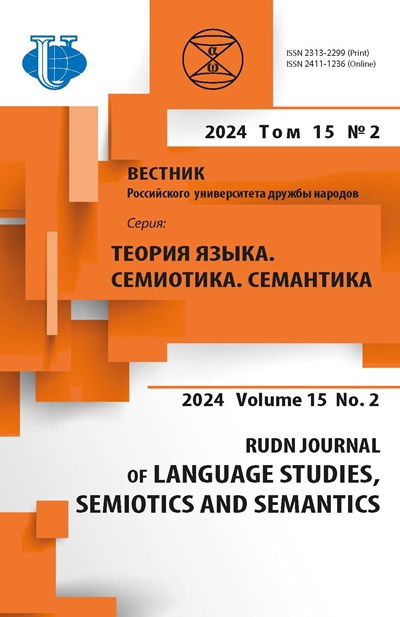Сопоставительный анализ речей Дональда Трампа и Барака Обамы
- Авторы: Касань-Питарч Р.1
-
Учреждения:
- Политехнический университет Валенсии
- Выпуск: Том 9, № 1 (2018)
- Страницы: 173-185
- Раздел: ПОЛИТИЧЕСКАЯ ЛИНГВИСТИКА. НАУКА 21.0
- URL: https://journals.rudn.ru/semiotics-semantics/article/view/18275
- DOI: https://doi.org/10.22363/2313-2299-2018-9-1-173-185
Цитировать
Полный текст
Аннотация
Речь всегда является репрезентацией личности каждого человека. То, как индивид обращается к аудитории и какие лексические единицы он использует, играет роль в определении его общественного имиджа. Представленная статья предлагает анализ лексико-грамматических средств в политическом дискурсе. Цель данного исследования - проанализировать языковые формы, которые отмечаются в речи Президента Соединенных Штатов Америки Дональда Трампа и его предшественника Барака Обамы, а также рассмотреть, как их речь влияет на их имидж политика. Метод, примененный в этом исследовании, основан на анализе трех основных позиций: 1) количество слов и длина предложений, 2) морфологический состав (композиция), а также 3) использование местоимений в их речи. В основу исследования легли шесть эквивалентных выступлений обоих Президентов в схожем контексте: обращение президента, речь при победе на выборах, инаугурационная речь. Результаты, полученные в ходе исследования, показывают значительную разницу между президентами с точки зрения анализируемого материала, а также подтверждают, что лексико-граматическое наполнение речей влияют на имидж политика. В заключение отметим, что есть несколько причин, по которым каждый Президент пользуется определенным типом дискурса для обращения к определенным классам и группам людей, готовых их поддержать.
Ключевые слова
Об авторах
Рикардо Касань-Питарч
Политехнический университет Валенсии
Email: ricapi@upv.es
- Ками де Вера, s/n, Валенсия, Испания, 46022
Список литературы
- Ahmadian, S., Azarshahi, S., & Paulhus, D.L. (2017). Explaining Donald Trump via communication style: Grandiosity, informality, and dynamism. Personality and Individual Differences, Elsevier, 107 (1), 49-53.
- Ajayi, T.M. & Balogun, K.U. (2015). Politeness in the Yoruba and French Languages. International Journal of Language Studies, 8 (4), 77-94.
- Beard, A. (2000). The language of politics. London: Routledge.
- Brunell, A.B., Gentry,W.A., Campbell,W.K., Hoffman, B.J., Kuhnert, K.W., & Demarree, K.G. (2008). Leader emergence: The case of the narcissistic leader. Personality and Social Psychology Bulletin, 34 (1), 1663-1676.
- Carreon, M.C. (2006). Unguarded patterns of thinking: physical and topical structure analysis of students’ journals. The Asia Pacific Education Research, 15 (1), 155-182.
- Casañ-Pitarch, R. (2016). Case study on banks’ webpages: The use of personal pronouns. International Journal of Language Studies, 10 (4), 37-58.
- Cornish, F. (2005). “Degrees of indirectness: Two types of implicit referents and their retrieval via unaccented pronouns”. In A. Branco, T. McEnery & R. Miktow (eds.). Anaphora processing: linguistic, cognitive and computational modeling. Amsterdam: John Benjamins. pp. 199-220.
- Collins, J. (2001). Good to great: Why some companies make the leap and others don’t. New York: Harper Business.
- Crystal, D. (1980). A First Dictionary of Linguistics and Phonetics. Boulder, CO: Westview.
- Djafarova, E. (2008). Why do advertisers use puns? A linguistic perspective. Journal of Advertising Research, 48 (2), 267-275.
- Deluga, R.J. (1997). Relationship among American presidential charismatic leadership, narcissism, and rated performance. The Leadership Quarterly, 8 (1), 49-65.
- Engelen, A., Neumann, C., & Schmidt, S. (2016). Should entrepreneurially oriented firms have narcissistic CEOs? Journal of Management, 42 (3), 698-721.
- Fortanet-Gomez, I. (2004). The use of ‘we’ in university lectures: reference and function. English for Specific Purposes, 23 (1), 45-66.
- Heylighen, F. & Dewaele, J.M. (1999). Formality of language: definition, measurement and behavioral determinants. Brussels: Free University of Brussels.
- Holtzman, N.S., & Strube, M.J. (2010). Narcissism and attractiveness. Journal of Research in Personality, 44 (1), 133-136.
- Íñigo-Mora, I. (2004). On the use of the personal pronoun we in communities. Journal of Language and Politics, 3 (1), 27-52.
- Jeon, H.J. (2003). Use of film dialogues as a model of natural conversation for developing conversational proficiency. Edinburgh: University of Edinburgh. URL: http://www.era.lib.ed.ac.uk/ bitstream/1842/486/1/Jude.pdf.
- Lafiti, V. The populism of the political discourse: Metamorphoses of political rh













